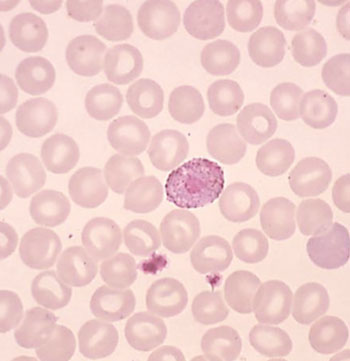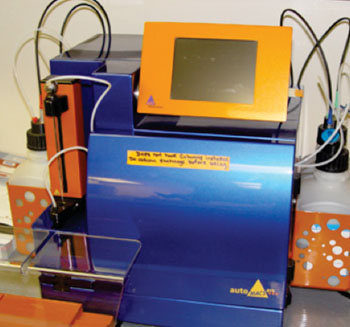Three Detection Methods Compared for Malaria Gametocytes
|
By LabMedica International staff writers Posted on 28 Aug 2014 |

Image: Blood smear showing a male gametocyte of Plasmodium vivax (Photo courtesy of Dr. Mae Melvin).

Image: Magnetic-activated cell sorting (MACS) equipment (Photo courtesy the University of South Carolina).
Gametocytes are the transmission stages of malaria parasites and as their density in the human host is typically low, they are often undetected by conventional light microscopy.
A detailed comparison of three methods, namely light microscopy, magnetic fractionation (MF) and reverse transcriptase polymerase chain reaction (RT-PCR) for detection of Plasmodium falciparum and P. vivax gametocytes has been conducted.
Scientists at the University of Western Australia (Fremantle, Australia) working with an international team took blood samples from total of 70 children, 56 with P. falciparum and 14 with P. vivax and aged between six months and five years. For the light microscopy Giemsa-stained thick blood smears were examined and parasite density quantified independently by two skilled microscopists with parasites counted against 500 white cells.
For the MF study the samples were subjected to high field gradient MF and magnetic particles (Spherotech; Lake Forest, IL, USA) were added to achieve a total known particle concentration of 100 particles per μL of blood. The samples were then magnetically fractionated using magnetic-activated cell sorting (MACS) equipment (Miltenyi Biotec; Bergisch Gladbach, Germany). For the RT-PCR study the team used the P. falciparum Pfs25 gene or the P. vivax Pvs25 gene copy number as a measure for gametocyte abundance. All RT-PCR assays were run in 384-well plate format on the LightCycler480 platform (Roche; Basel, Switzerland).
The scientists found that MF and RT-PCR were similarly sensitive and specific, and both were superior to light microscopy (LM). Overall, there were approximately 20% gametocyte-positive samples by LM, whereas gametocyte positivity by MF and RT-PCR were both more than two-fold this level. In the subset of samples collected prior to treatment, 29% of children were positive by LM, and 85% were gametocyte positive by MF and RT-PCR, respectively. MF is a feasible methodology for field-based gametocyte detection that can be applied even in larger scale studies. With an appropriate set- up, four to six samples could conveniently be processed by one person in an hour with results being available for all samples after approximately 90 minutes.
The authors concluded that that magnetic fractionation is a very good alternative method for on-site gametocyte detection under field conditions. The method has, as previously shown under laboratory conditions, similar sensitivity to RT-PCR and can be used to derive quantitative gametocyte densities for both P. falciparum and P. vivax. The study was published on August 14, 2014, in the Malaria Journal.
Related Links:
University of Western Australia
Spherotech
Miltenyi Biotec
A detailed comparison of three methods, namely light microscopy, magnetic fractionation (MF) and reverse transcriptase polymerase chain reaction (RT-PCR) for detection of Plasmodium falciparum and P. vivax gametocytes has been conducted.
Scientists at the University of Western Australia (Fremantle, Australia) working with an international team took blood samples from total of 70 children, 56 with P. falciparum and 14 with P. vivax and aged between six months and five years. For the light microscopy Giemsa-stained thick blood smears were examined and parasite density quantified independently by two skilled microscopists with parasites counted against 500 white cells.
For the MF study the samples were subjected to high field gradient MF and magnetic particles (Spherotech; Lake Forest, IL, USA) were added to achieve a total known particle concentration of 100 particles per μL of blood. The samples were then magnetically fractionated using magnetic-activated cell sorting (MACS) equipment (Miltenyi Biotec; Bergisch Gladbach, Germany). For the RT-PCR study the team used the P. falciparum Pfs25 gene or the P. vivax Pvs25 gene copy number as a measure for gametocyte abundance. All RT-PCR assays were run in 384-well plate format on the LightCycler480 platform (Roche; Basel, Switzerland).
The scientists found that MF and RT-PCR were similarly sensitive and specific, and both were superior to light microscopy (LM). Overall, there were approximately 20% gametocyte-positive samples by LM, whereas gametocyte positivity by MF and RT-PCR were both more than two-fold this level. In the subset of samples collected prior to treatment, 29% of children were positive by LM, and 85% were gametocyte positive by MF and RT-PCR, respectively. MF is a feasible methodology for field-based gametocyte detection that can be applied even in larger scale studies. With an appropriate set- up, four to six samples could conveniently be processed by one person in an hour with results being available for all samples after approximately 90 minutes.
The authors concluded that that magnetic fractionation is a very good alternative method for on-site gametocyte detection under field conditions. The method has, as previously shown under laboratory conditions, similar sensitivity to RT-PCR and can be used to derive quantitative gametocyte densities for both P. falciparum and P. vivax. The study was published on August 14, 2014, in the Malaria Journal.
Related Links:
University of Western Australia
Spherotech
Miltenyi Biotec
Latest Microbiology News
- New AI-Based Method Improves Diagnosis of Drug-Resistant Infections
- Breakthrough Diagnostic Technology Identifies Bacterial Infections with Almost 100% Accuracy within Three Hours
- Innovative ID/AST System to Help Diagnose Infectious Diseases and Combat AMR
- Gastrointestinal Panel Delivers Rapid Detection of Five Common Bacterial Pathogens for Outpatient Use
- Rapid PCR Testing in ICU Improves Antibiotic Stewardship
- Unique Genetic Signature Predicts Drug Resistance in Bacteria
- Unique Barcoding System Tracks Pneumonia-Causing Bacteria as They Infect Blood Stream
- Rapid Sepsis Diagnostic Test Demonstrates Improved Patient Care and Cost Savings in Hospital Application
- Rapid Diagnostic System to Detect Neonatal Sepsis Within Hours
- Novel Test to Diagnose Bacterial Pneumonia Directly from Whole Blood
- Interferon-γ Release Assay Effective in Patients with COPD Complicated with Pulmonary Tuberculosis
- New Point of Care Tests to Help Reduce Overuse of Antibiotics
- 30-Minute Sepsis Test Differentiates Bacterial Infections, Viral Infections, and Noninfectious Disease
- CRISPR-TB Blood Test to Enable Early Disease Diagnosis and Public Screening
- Syndromic Panel Provides Fast Answers for Outpatient Diagnosis of Gastrointestinal Conditions
- Culture-Free Platform Rapidly Identifies Blood Stream Infections
Channels
Clinical Chemistry
view channel
Carbon Nanotubes Help Build Highly Accurate Sensors for Continuous Health Monitoring
Current sensors can measure various health indicators, such as blood glucose levels, in the body. However, there is a need to develop more accurate and sensitive sensor materials that can detect lower... Read more
Paper-Based Device Boosts HIV Test Accuracy from Dried Blood Samples
In regions where access to clinics for routine blood tests presents financial and logistical obstacles, HIV patients are increasingly able to collect and send a drop of blood using paper-based devices... Read moreMolecular Diagnostics
view channelNovel Cell-Based Assay Provides Sensitive and Specific Autoantibody Detection in Demyelination
Anti-myelin-associated glycoprotein (MAG) antibodies serve as markers for an autoimmune demyelinating disorder that affects the peripheral nervous system, leading to sensory impairment. Anti-MAG-IgM antibodies... Read more
Novel Point-of-Care Technology Delivers Accurate HIV Results in Minutes
HIV diagnostic methods have traditionally relied on detecting HIV-specific antibodies, which typically appear weeks after infection. This delayed detection has hindered early diagnosis, complicating patient... Read moreHematology
view channel
New Scoring System Predicts Risk of Developing Cancer from Common Blood Disorder
Clonal cytopenia of undetermined significance (CCUS) is a blood disorder commonly found in older adults, characterized by mutations in blood cells and a low blood count, but without any obvious cause or... Read more
Non-Invasive Prenatal Test for Fetal RhD Status Demonstrates 100% Accuracy
In the United States, approximately 15% of pregnant individuals are RhD-negative. However, in about 40% of these cases, the fetus is also RhD-negative, making the administration of RhoGAM unnecessary.... Read moreImmunology
view channel
Stem Cell Test Predicts Treatment Outcome for Patients with Platinum-Resistant Ovarian Cancer
Epithelial ovarian cancer frequently responds to chemotherapy initially, but eventually, the tumor develops resistance to the therapy, leading to regrowth. This resistance is partially due to the activation... Read more
Machine Learning-Enabled Blood Test Predicts Immunotherapy Response in Lymphoma Patients
Chimeric antigen receptor (CAR) T-cell therapy has emerged as one of the most promising recent developments in the treatment of blood cancers. However, over half of non-Hodgkin lymphoma (NHL) patients... Read morePathology
view channel
AI Model Effectively Predicts Patient Outcomes in Common Lung Cancer Type
Lung adenocarcinoma, the most common form of non-small cell lung cancer (NSCLC), typically adopts one of six distinct growth patterns, often combining multiple patterns within a single tumor.... Read more
AI Model Predicts Patient Response to Bladder Cancer Treatment
Each year in the United States, around 81,000 new cases of bladder cancer are diagnosed, leading to approximately 17,000 deaths annually. Muscle-invasive bladder cancer (MIBC) is a severe form of bladder... Read moreTechnology
view channel
Pain-On-A-Chip Microfluidic Device Determines Types of Chronic Pain from Blood Samples
Chronic pain is a widespread condition that remains difficult to manage, and existing clinical methods for its treatment rely largely on self-reporting, which can be subjective and especially problematic... Read more
Innovative, Label-Free Ratiometric Fluorosensor Enables More Sensitive Viral RNA Detection
Viruses present a major global health risk, as demonstrated by recent pandemics, making early detection and identification essential for preventing new outbreaks. While traditional detection methods are... Read moreIndustry
view channel
Cepheid and Oxford Nanopore Technologies Partner on Advancing Automated Sequencing-Based Solutions
Cepheid (Sunnyvale, CA, USA), a leading molecular diagnostics company, and Oxford Nanopore Technologies (Oxford, UK), the company behind a new generation of sequencing-based molecular analysis technologies,... Read more
Grifols and Tecan’s IBL Collaborate on Advanced Biomarker Panels
Grifols (Barcelona, Spain), one of the world’s leading producers of plasma-derived medicines and innovative diagnostic solutions, is expanding its offer in clinical diagnostics through a strategic partnership... Read more
























